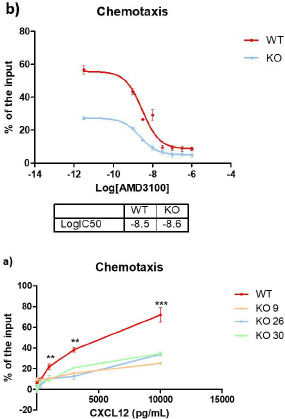| 052P Nottingham, UK 7th Focused Meeting on Cell Signalling |
Role of ACKR3 in CXCR4-dependent cell migration
Introduction: ACKR3, previously called CXCR7, is a class A GPCR which belongs to the atypical chemokine receptor subfamily (1). Appreciation that ACKR3 is able to bind the chemokine ligands CXCL12 and CXCL11 introduced a further interacting receptor to the previously established CXCR4/CXCL12 axis, the role of which in stromal cell homing and cancer metastasis is well established (2). Jurkat cells are an adult T-cell leukaemia line known to express both ACKR3 and CXCR4. These receptors have been suggested to hetero-dimerise and thus elimination of CXCR7 from this cell line might be useful in understanding its role in cell functions, including cell migration (3).
Methods: To obtain ACKR3 KO cells CRISPR/Cas9 mediated genome-editing was employed. ACKR3 guide RNAs were designed and inserted into a GFP-labelled nickase Cas9 D10A vector. Jurkat cells were then electroporated and 24 hours later GFP+ cells were single-cell sorted into 96 well plates. Empty vector transfectant clones were used as controls. Cell migration was assessed following clonal cell expansion using 5 μm transwell inserts. Statistics were obtained using unpaired t-test.
Results: Potential ACKR3 KO clones were selected first by PCR, then by sequencing and flow cytometry: both the ACKR3 alleles of each clone presented an insertion or deletion, and all of them showed introduction of a frameshift predicted to introduce a premature stop codon within the N terminal region. In clones lacking ACKR3, migration towards concentration gradients of the chemokine ligand CXCL12 showed a quantitatively significant reduction in the number of migrated cells compared to their wild type cell controls (Figure 2a). The CXCR4 inhibitor AMD3100 (Plerixafor) inhibited migration to same extent in both control and ACKR3 deleted clones (Figure 2b).
Conclusions: These results indicate that the atypical chemokine receptor ACKR3 contributes quantitatively to CXCR4-dependent cell migration in Jurkat cells although it is unable to promote cell migration in isolation, i.e., when the interaction of CXCR4 with CXCL12 is prevented by selective antagonist.
References:
(1) Bachelerie, F et al (2014). Pharmacological Reviews 66, 1-79.
(2) Scala, S. (2015). Clinical Cancer Research 21, 4278-85.
(3) Melo, RdCC et al (2014). PloS ONE 9, 1-12.

Figure 1: a) Chemotaxis in response to various concentrations of CXCL12: Wild type migration is greater than the three illustrated clones lacking ACKR3 ** p < 0.01, *** p < 0.001; b) inhibition curves obtained by treating cells with different concentrations of the CXCR4 antagonist AMD3100.

